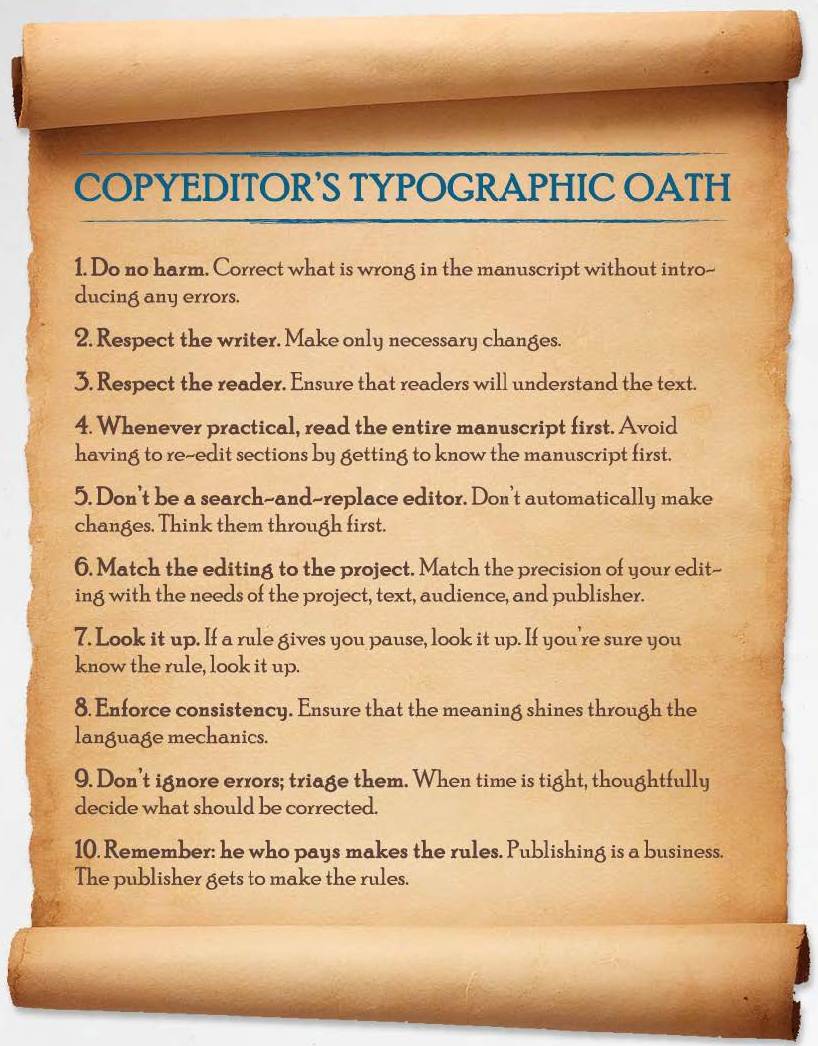Copyeditors are often cautioned against changing the writing style of a manuscript. They’re told to protect and sometimes refine the author’s voice. But what does that really mean?
Style and voice are slippery terms at best. They overlap and are sometimes used interchangeably. Many writing instructors and texts even duck defining them, instead opting for clichéd advice: “You have to dig deep into yourself to find your writing style,” authors are told. “Your voice is you. It is as unique as you are. Just keep writing and you’ll find it!”
Poppycock.
Authors are not limited to one writing style. And while practice—combined with writing critiques—is the best way to get better at writing, style is developed, not found by some nebulous means. It’s a matter of learning how to use writing mechanics to produce the desired style. The science of writing leads to the art of it.
Editors, too, need to understand writing style. A copyeditor’s goals are, first, to do no harm and, second, to improve the manuscript. Not to make it as we would write it, but to help the manuscript be its best self. Check out my “Copyeditor’s Typographic Oath,” a list of suggested “commandments” for a copyeditor to follow, below:

How can we do all of this if we don’t understand how writing style works? To rely on instinct alone is to limit the help we can give the manuscript and risk unintentionally damaging the writing. We can understand how it works—and, as a result, how to fix it—by examining three key elements of any writing style: words, sentences, and paragraphs.
Words as Building Blocks
We start at the core of writing: individual words. In English, we use just 26 letters to create what some estimate to be a million words—and we’re creating thousands more every year, though not all of them stick around. Some words die away, but even a word on its deathbed can be kept alive by being read, loved and put back into use.
Take madding, for example. I read Thomas Hardy’s Far from the Madding Crowd recently (a lovely, lyrical book). Hardy picked up madding from Thomas Gray’s poem “Elegy Written in a Country Churchyard,” published in 1751, nearly 125 years before Madding Crowd was published. The word had been declining in usage in books, but it received a bump when Hardy came along.
Its usage then dipped again before leveling off. Madding appears just 83 times in the Corpus of Contemporary American English, which includes over a billion words from 1990 to 2019.
With all of these words at an author’s disposal, the words they choose strongly affect their style. Does your author favor common, more direct words, or do they reach for rarer words like madding, formal words, or more challenging words? Do they prefer slang and colloquialisms? Neologisms? Jargon and specialty terms?
How does the author use words? Do they prefer literal meanings or metaphors? Is the author descriptive, using a lot of vivid, strong verbs, adjectives, and adverbs?
These characteristics build the author’s vocabulary—the first step toward style. Look for patterns of usage and anomalies. Refining a style can mean pulling back on overused patterns or removing anomalies that don’t serve a purpose.
Putting Blocks into Units
Next we look at how words are fitted together into sentences, developing the rhythm we unconsciously hear as we read. In The Oxford Essential Guide to Writing, Thomas Kane identifies three grammatical sentence structures:
- Simple, which contains one independent clause: The boy ran down the street.
- Compound, which contains two or more independent clauses: The boy ran and the dog chased him.
- Compound-Complex, which contains at least two independent clauses and one dependent clause: The boy ran when the dog lunged at him, and the dog’s owner quickly grabbed the dog’s leash.
Kane then defines seven patterns, or styles, of sentences from those sentence structures:
- Segregating: A relatively short, uncomplicated sentence
- Freight-train: Short, independent clauses linked together
- Cumulative: An independent clause followed by subordinate clauses building on the main idea
- Parallel: Parallel grammatical forms, such as parallel subjects
- Balanced: Two parts of about the same length and importance, divided by a pause
- Subordinating: An independent clause surrounded by subordinate clauses of less important ideas
- Fragment: An incomplete sentence
Kane additionally defines two groups of substyles. Freight-trains might be multiple coordination sentences, in which clauses are linked with coordinating conjunctions (most often and). Or they might be parataxis sentences: sentences that combine independent clauses with semicolons or sometimes commas.
Subordinating style comes in four patterns:
- Loose: Main clause, then subordinate constructions
- Periodic: Subordinate constructions, then main clause
- Convoluted: Main clause split in two by subordinating constructions
- Centered: Subordinating construction, main clause, subordinating constructions
With so many sentence structures and word choices, two authors writing on the same topic who both favor a simple structure can create wildly different sentences. Consider the difference between these two (grammatically) simple sentences:
The boy ran down the street.
The boy ran quickly down the long, narrow street, chasing the dog he had been asked to watch and struggling to avoid the crowd of people coming toward him.
Grouping Units into Chunks
And that brings us to how paragraphs further define a writing style. As the author groups sentences together into one chunk—the paragraph—the rhythm of the writing develops further. What sentence structures does a given paragraph favor? Are the sentences long or short?
Copyeditors are well aware that variety is key for producing a rhythm appropriate for the text. A paragraph full of long, simple sentences will plod along, making the reader wish the author would just get on with it. A paragraph of short, simple sentences might make the reader think the author is talking down to them, unless the text is aimed at reading learners.
How the author orders the sentences in a paragraph is part of style, too. I’d wager that most of us were taught to put the topic sentence first, followed by explanatory sentences and then a concluding sentence: a basic persuasive structure. That works well for essay writing, but how well does it work in a novel? Here’s a paragraph from The Great Gatsby:
The lights grow brighter as the earth lurches away from the sun, and now the orchestra is playing yellow cocktail music, and the opera of voices pitches a key higher. Laughter is easier minute by minute, spilled with prodigality, tipped out at a cheerful word. The groups change more swiftly, swell with new arrivals, dissolve and form in the same breath; already there are wanderers, confident girls who weave here and there among the stouter and more stable, become from a sharp, joyous moment the center of a group, and then, excited with triumph, glide on through the sea-change of faces and voices and color under the constantly changing light.
You’d be challenged to find a topic sentence in that paragraph, though clearly there’s a pattern. It’s a descriptive paragraph, rather than the persuasive paragraph we learned for essay writing.
Other types of paragraphs our writers might employ include the expository paragraph and the narrative paragraph. Both employ a sequence: the first in describing steps, as in a process, and the second in describing a scene with a beginning, middle, and end. And that’s just for starters. Some resources list seven types of paragraphs, while others list nine. It’s a bit like comma rules: the number of rules you get depends greatly on how you view uses.
Putting It All Together
Using the basic writing-style elements of words, sentences, and paragraphs, how do you, the editor, go about identifying a writer’s style?
I write and edit a lot of business and marketing copy, and I frequently describe the writing style I apply as “business casual,” deliberately referencing a popular office dress style. Business casual generally means slacks or chinos, colored shirts or blouses, sweaters, and comfortable shoes. However, it also generally means no jeans, sneakers, open-toed shoes, or loud or novelty patterns.
Here’s how I translate that into a writing style:
- Words: Moderate use of business vocabulary and jargon, mixed with some casual words and inoffensive slang; easy on the 50-cent words; a professional, respectful tone; no vulgarities or disrespectful terms
- Sentences: Fewer compound-complex sentences and more simple and compound sentences, with a sprinkling of fragments; a variety of short and long sentences, with complex concepts generally put into more than one sentence
- Paragraphs: Shorter paragraphs, with a few one-sentence or one-word paragraphs for emphasis; more persuasive or explanatory paragraphs, with fewer narrative and descriptive paragraphs
There’s More to Writing Style
There’s much more we can gather from writing mechanics to help us define a specific style, such as point of view, voice (active or passive), variety and repetition of ideas, and language register (e.g., formal, informal). Research definitions of writing style and you’ll get as many different answers as you get results. But copyeditors charged with maintaining or refining an author’s writing can analyze the text to determine the manuscript’s writing style—without getting lost in the details—and use well-known writing mechanics to make the manuscript the best it can be.
This article originally published in the April–May 2018 issue of the Copyediting newsletter.



One thoughts on “Using Science to Define the Art of Writing Style”